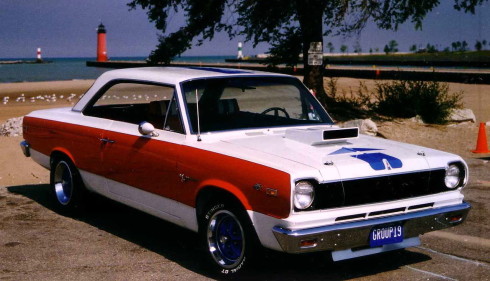
(1969 SC/Rambler in ‘A-scheme’ paint photographed at the beach in Kenosha, Wisconsin. I almost bought it yesterday and was saved only buy an important phone call at the end of the auction).
I apologize for this- I had, as a general concept, considered limiting this narrative to cars and people I actually knew, or were intentionally influential on Dad’s career in cars or the people with whom he interacted. That includes some of the seminal thinkers and designers of that long-ago Detroit, so it is a fairly wide net to cast, and the harvest is a bounty of memories and might-have-beens.
I had one yesterday, that came within minutes of saddling me with another new project, but I will have to get to that in a minute.
I got around to mentioning the SC/Rambler yesterday. It is a curiosity of the Speed Age, and it is worth talking a little more about it. My pal Jake had once in his driveway- left there by a boyhood friend who was deploying and needed to find a place to park it.
Jake still marvels at the thing- as recently as last night at Willow. He said the clutch to the Hurst Shifter was actually an exercise in free weights for the left leg, a binary choice between free and engaged status, and the rumble of the exhaust out from under the little Rambler American body could be heard for blocks around.
The Scrambler was the apex of what the car guys in the AMC concept shop could do with the limited resources available to them through the manufacturing plant in Kenosha, Wisconsin.
The term “Detroit” as synonym for the auto industry includes places like Ohio and Indiana, of course, but also way up to the north. Dad’s little fabrication plant in The Village By the Bay was a UAW shop. Across the Big Lake, Kenosha reverberates with historic innovation like the steering wheel, the seat belt, and the muscle car.
It was in Kenosha in 1902 that Thomas Jeffrey made a mass-assembly automobile, the Rambler, a year ahead of Henry Ford. We were indoctrinated early with the pride in the Rambler marque- we had to. All the Rambler kids had a bit of a chip on their shoulders over the status issue with the Big Three kids, even if the seats in our cars reclined “all the way,” due to Kenosha’s practical application designed to allow Rambler owners to sleep- or something- in their cars.
Remind me to tell you about the Oak Drive In Theater off Woodward some time. Or not.
Kenosha was also instrumental in the history of worker rights. Auto workers in Kenosha unionized in 1933, two years before the United Auto Workers was formed.
Like Detroit proper, Kenosha was once dominated by the manufacture of automobiles. There were two major factories and a host of smaller jobbers that supplied them with parts. One of the big plants was on the shores of Lake Michigan, and the other a mile inland where workers produced Nash, American Motors, Renault and finally Chrysler vehicles before it closed- quietly- in October of 2010.
In the heyday of the business- the 1950s and 60s- 16,000 Kenosha jobs were supported by the industry.
Jim Alexander was one of Dad’s best pals. He was The Man in the AMC interior studio, and a committed car guy. He was a racing enthusiast, and I would argue that he was the pivotal link in what became the Scrambler. He brokered a friendship with Grand Prix ace driver Dan Gurney which became a link to all sorts of racing activities.
His enthusiasm for performance was legendary- one of his last projects in retirement was a pre-fabricated and functional wing derived from formula racers to mount on his trailer for better handling. I know he was one of the guys who sat around with a beer in the afternoon, saying, “Well, suppose we put the 390 AMX V-8 into the Rambler American body? We could paint it up really cool and have a bunch of custom goodies in it. We could call it the Super Car- the SC/Rambler!”
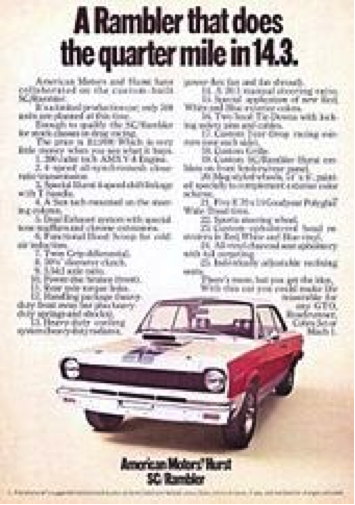
The boys in Kenosha harnessed the street creds of Hurst Performance to produce one of the most outrageous muscle cars of the Golden Age of Speed. Limited to a production run of 1,512 units in two paint schemes, it was probably the only production model made and promoted for a specific class of drag cars- the National Hot Rod Association F/Stock class.
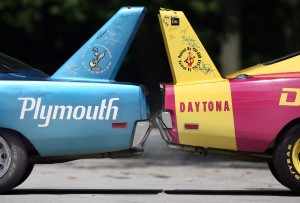
Don’t go all MoPar on me here- I know the Dodge Daytona and the Plymouth Superbird were manufactured the year before in a production run of 2,500 to qualify as “stock cars” to run in the NASCAR challenge series.
American Motors chose their niche and optimized the Scrambler for straight-ahead raw power in light weight. No wings required. A true muscle car with zero options and an MSRP of less than $3,000 bucks- hell, what could go wrong?
(Note, that is still just a little south of $20,000 2014 dollars- a point you will want to recall later).
Each no-frills Hurst SC/Rambler came equipped out of the box with the 315-horsepower 390 cubic inch AMX V-8. The standard clutch Jake marveled about was a 10.5 inch model with three finger long-style Borg and Beck pressure plate. The 390 engine was mated to a manual four-speed Hurst four speed T-10 tranny with close gear ratios and manipulated with one of those over-the-top aluminum shifters. The rear end was an AMC 3.54:1 “Twin-Grip” limited slip differential with Dana internal workings.
It all hung together remarkably well with outer wheel hubs attached through a spline-and-keyway system, though critics assail the hub attachment method as the only weak point in the rear end assembly.
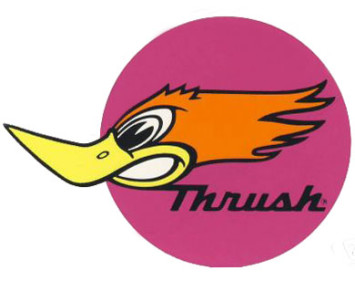
Acoustics were important to the whole experience. Factory cast iron manifolds exited the block to a true dual exhaust with Thrush two-chamber oval mufflers with the famed Woodpecker logos. These were standard baffled mufflers, not glass packs. Minimal baffling gave a deep throaty sound, similar to modern Flowmasters. The exhaust exited through chrome tips attached with hose clamps.
The SC package came with front discs, a heavy-duty sway bar, as well as strengthened drive train and body components. These included connectors between the front and rear sub-frames. The rear end used staggered (fore and aft) rear shock absorbers to eliminate the wheel hop common with leaf spring suspensions. The staggered shocks required a special plate riveted in the trunk pan, as well as brackets for the sub-frame end of upper torque links.
Other body modifications included rolling back front and rear wheel well openings to allow for larger tires.
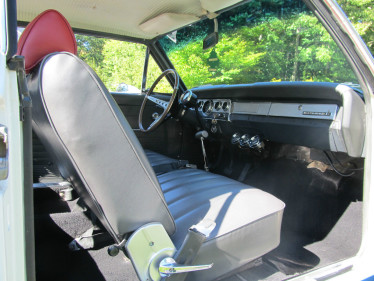
(Standard SC/Rambler interior in gray vinyl. The famous seat-lowering lever is at the center bottom.)
There was no convertible option. They were all hard-tops to give the body some rigidity. The interiors likewise had no options- the interiors came in standard gray charcoal vinyl reclining bucket seats (you could take the Scrambler to the Oak with pride!) and a paper headliner embossed with small squares. The Federally-mandated new headrests came only in red, white, and blue. For extra instrumentation (and to avoid over-revving the engine), the Sun tachometer attached to the steering column with a stainless hose clamp.
Out front on the hood, the SC Rambler featured a forward-facing functioning box-type hood scoop with a vacuum-operated air flapper to induce higher-pressure air into the Carter AFB carb.
Some of the other unique standard items on this model included racing mirrors, anti-hop rear axle links, and blue Magnum 500 steel wheels (common to Fords) with chrome beauty rings and AMC hub centers. Tires were E-70-14 fiberglass belted 4-ply tires with red stripe Goodyear Polyglas radial tires.
I managed to shred a right rear tire on the 1968 AMC Javelin doing something stupid on I-96 one time- I was lucky- the fiberglass stayed intact and I had no control problems bringing the pony car to a safe halt on the side of the interstate.
If you got home safely from the Dealer, you had a serious quarter mile contender that would do- unmodified- low 14-second ETs at more than a hundred mph at terminal speed. With a few simple after-market mods, a shade-tree racer could better that to the low 12 seconds, and some boasted times in the 9-second range.
So why would I burden you with all that trivia? I mean, wouldn’t it do to just say that they are still around at the AMC Rallies and they were faster than a scalded dog?
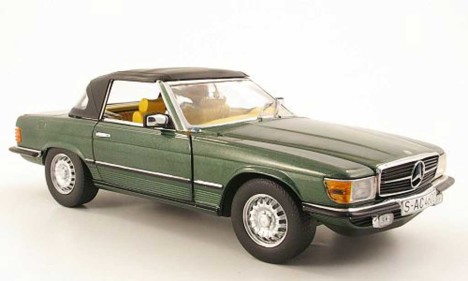
(1972 Mercedes 350SL convertible. Drove like a truck and smelled like petroleum distillates. Fun car, I tended not to smoke while I drove it).
Well, I almost bought one yesterday. You know the deal- looking for a comprehensive set of pictures to illustrate the story I wound up at the EBay Motors site where I accidentally bought a Mercedes 350SL a few years ago. Great car, BTW, but I have a hard time controlling myself around cool cars.
The phone went off as the auction was winding down to the last few minutes. I got the Mercedes through the application of a new algorithm called “Sniper,” or something. It was adapted from the Wall Street automatic trading software, and jumps in at the last second to beat whatever the leading bid is at that second.
Quickest I ever spent $10,00 bucks up to that time. They have improved things since then- you can protect yourself with a “maximum bid” ceiling and I was wondering what it might be. As the minutes ticked down, the winning bid was hovering right around $20,000. I thought it would be a real value, but was struggling with the maximum bid I might offer.
I thought maybe $29 grand might be reasonable, and was about to enter the dollar amount when the cell phone went off. It was Old Jim, seeking to discover my whereabouts, and whether I was going to stop by Willow for a drink that evening. We exchanged pleasantries and I signed off and walked back to the computer. The auction had ended, and the winning bid was $21,200.
Damn. I could have been S/CRambling today.
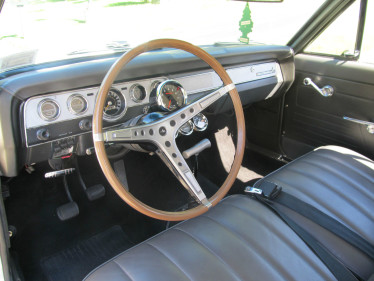
Copyright 2014 Vic Socotra
www.vicsocotra.com
Twitter: @jayare303
